Trumpeter 1/350 DKM Graf
Spee
|
KIT #: |
5316 |
|
PRICE: |
$84.00 |
|
DECALS: |
One option |
|
REVIEWER: |
Tom Cleaver |
|
NOTES: |
Eduard and White Ensign Models photoetch used. |
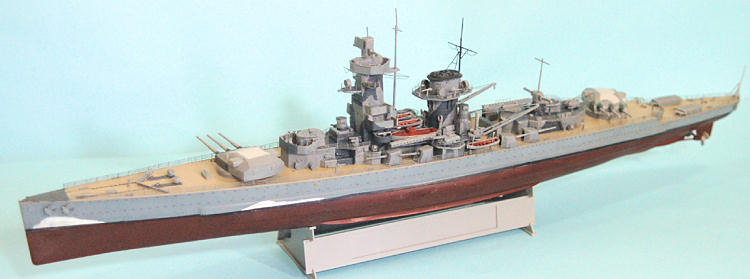
DKM Admiral Graf Spee was a Deutschland‑class
Panzerschiff - one of three, the others being Deutschland and
Admiral Scheer - laid down at the Reichsmarinewerft shipyard in
Wilhelmshaven in October 1932, launched June 30, 1934, and completed on January
6. 1936. She was named after
Admiral Maximilian von Spee, who commanded
the East Asia Squadron that fought the battles of Coronel and Falkland
Islands in 1914, where the Admiral died in action.
Developed in the 1920s, the Panzerschiff concept was a response by
the German Navy to the restrictions imposed on the size of warships allowed
under the
Versailles
Treaty, which imposed a maximum size of 10,000 tons on any German warship.
(Though with a full load displacement of 16,280 tons, she significantly exceeded
the restriction). The ship was
essentially the size of a heavy cruiser, with the armament of a battle cruiser:
six 11-inch guns in two triple gun turrets, and thus able to outgun any
cruiser fast enough to catch her, while the ship's top speed of 29.5 knots meant
that only a handful of ships in the Anglo‑French navies would be able to catch
them and powerful enough to sink them.
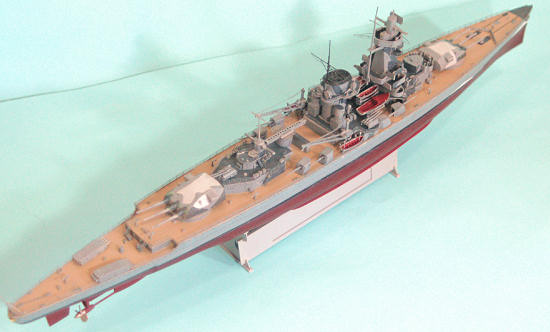 The ships were primarily designed to operate as open ocean commerce
raiders, powered by four
MAN
9‑cylinder double‑acting two‑stroke diesel engines.
The fuel oil was extended by mixing it with desalinated water, utilizing
some complicated machinery coupled to the ship's desalinization system, which
would turn out to be the Achilles Heel of Admiral Graf Spee.
The ships were primarily designed to operate as open ocean commerce
raiders, powered by four
MAN
9‑cylinder double‑acting two‑stroke diesel engines.
The fuel oil was extended by mixing it with desalinated water, utilizing
some complicated machinery coupled to the ship's desalinization system, which
would turn out to be the Achilles Heel of Admiral Graf Spee.
After three months working up following her commissioning, Admiral
Graf Spee became the flagship of the German Navy.
Following the outbreak of the Spanish Civil War in July 1936, the ship
participated in three “non‑intervention patrols” (in which the navies of
Great Britain,
France,
Germany
and
Italy
effectively cut off the legal Republican government from aid to oppose the
illegal fascist revolt supported by
Germany
and
Italy)
between August 1936 and May 1937.
Returning from Spain, the represented Germany in the Coronation Review at
Spithead for King George VI on May 20, 1937, after which she made a fourth
non‑intervention patrol. After
fleet maneuvers and a brief visit to
Sweden,
Graf Spee made a fifth and final patrol in February 1938.
Kapitan zur See Hans Ludendorff became Graf Spee's third and final
commander following her return from
Spain.
In the spring of 1939, Graf Spee became the first German warship equipped
with radar, when a FMG G(gO) "Seetakt" set was mounted on the fire
control tower.
On
August 21, 1939,
Graf Spee departed
Wilhelmshaven
bound for the
South Atlantic,
under orders to place herself in the shipping lanes following the possible
outbreak of war.
Hitler held off ordering the pre-positioned German warships to undertake
commerce raiding until it was clear that
Britain
would not consider a peace treaty following the conquest of
Poland.
Graf Spee was ordered to commence operations on
September 26, 1939,
strictly following the rules of the sea for commerce raiding, which meant ships
were to be stopped and searched, and provision made for the crews before sinking
them. Graf Spee had narrowly
avoided a fight with HMS Cumberland on September 11, when the British
cruiser narrowly missed finding the German warship with her tender, the
Altmark, off the
Canary Islands
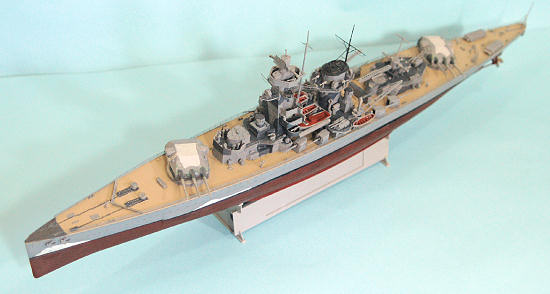 Between September 30 and
December 7, 1939,
Graf Spee stopped and sank nine ships totaling some 50,000 tons in the
South Atlantic
and southern
Indian Ocean.
On
October 5, 1939,
eight Franco-British task forces were organized to hunt down
Graf Spee in the
South Atlantic.
The forces included the British carriers HMS Hermes, Eagle, and Ark
Royal and the French carrier Béarn, the British battle cruiser
Renown, and the French battleships Dunkerque and
Strasbourg.
Sixteen cruisers were assigned, including Force G, commanded by Commodore
Henry Harwood, which patrolled the eastern coast of
South America
and comprised the heavy cruisers
Cumberland
and
Exeter,
reinforced by the light cruisers HMS Ajax (flagship) and HMNZS
Achilles. Cumberland
patrolled the Falkland Islands while the other three cruisers patrolled off the
River Plate, the border between
Uruguay
and
Argentina.
Between September 30 and
December 7, 1939,
Graf Spee stopped and sank nine ships totaling some 50,000 tons in the
South Atlantic
and southern
Indian Ocean.
On
October 5, 1939,
eight Franco-British task forces were organized to hunt down
Graf Spee in the
South Atlantic.
The forces included the British carriers HMS Hermes, Eagle, and Ark
Royal and the French carrier Béarn, the British battle cruiser
Renown, and the French battleships Dunkerque and
Strasbourg.
Sixteen cruisers were assigned, including Force G, commanded by Commodore
Henry Harwood, which patrolled the eastern coast of
South America
and comprised the heavy cruisers
Cumberland
and
Exeter,
reinforced by the light cruisers HMS Ajax (flagship) and HMNZS
Achilles. Cumberland
patrolled the Falkland Islands while the other three cruisers patrolled off the
River Plate, the border between
Uruguay
and
Argentina.
The
Battle
off the River Plate:
Based on shipping intelligence taken by the prize crew from the S.S.
Streonshalh, the last ship sunk by Graf Spee, Langsdorff headed for
the area off the River Plate, where many shipping lanes across the South
Atlantic converged, deciding to interrupt the Anglo-Argentinian beef trade.
At 0530,
December 13, 1939,
lookouts aboard Graf Spee spotted smoke on the horizon and a pair of masts off
the starboard bow, which Langsdorff concluded was the escort for the convoy
mentioned in the papers taken from Streonshalh.
At 0552 the other ship was identified as HMS Exeter, accompanied
by what appeared at that moment to be two destroyers.
At 0608,
Exeter
spotted Graf Spee, and Commodore Harwood divided his force in accordance
with plans made with his captains to allow the relatively light force to divide
Graf Spee's attention and fire in action.
Graf Spee opened fire on
Exeter
with her main battery and on
Ajax
with her secondary battery at 0617.
Exeter commenced return fire at 0620, with
Ajax
opening fire at 0621. Achilles
opened fire at 0623. In 30 minutes
of firing, Graf Spee hit
Exeter
three times, putting her two forward turrets out of action, destroying her
bridge and aircraft, and starting fires aboard the ship.
Harwood, aboard Ajax, brought the two light cruisers in close to
take pressure off
Exeter.
Thinking the two were about to make a torpedo attack, Langsdorff turned
away and made smoke, then commenced firing at the two light cruisers with his
main battery.
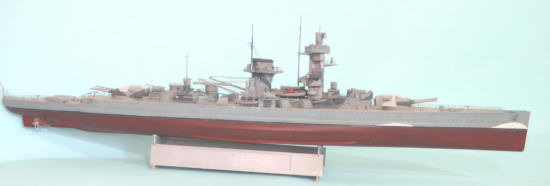 Exeter, having suffered 61 dead and 23 wounded, with only her after
turret able to fire, returned to the action at 0700 and scored the most
important hit of the battle when she struck Graf Spee just abaft her
aircraft catapult on the starboard side.
This wrecked the machinery for mixing diesel fuel with desalinated water,
as well as destroying the ship's desalinization system.
Graf Spee again hit Exeter, forcing her to pull out of the
action altogether, with a list to port.
Exeter, having suffered 61 dead and 23 wounded, with only her after
turret able to fire, returned to the action at 0700 and scored the most
important hit of the battle when she struck Graf Spee just abaft her
aircraft catapult on the starboard side.
This wrecked the machinery for mixing diesel fuel with desalinated water,
as well as destroying the ship's desalinization system.
Graf Spee again hit Exeter, forcing her to pull out of the
action altogether, with a list to port.
At 0725, after approximately one hour in battle, Graf Spee hit
Ajax
and put her two after turrets out of action.
Harwood was forced to break off action, and Graf Spee turned away
and entered the River Plate estuary, steaming toward the port of Montevideo,
which she entered an hour later.
Graf Spee had suffered 70 hits of 8-inch and 5.7-inch shells, with 36 dead
and 60 wounded, including Langsdorff.
News of the battle flashed around the world as the German warship dropped
anchor in the harbor. International
law required that she leave within 72 hours or suffer internment. Speculation
was rampant as to when the battle would resume.
Harwood's battered force was incapable of stopping Graf Spee if
she sortied, and the nearest British heavy force, HMS Renown and Ark
Royal, was 2,500 miles distant.
Cumberland immediately left the Falklands, but it would take longer than
72 hours for her to make the River Plate.
Ashore, diplomats sparred, with the Germans requesting an extension of
the time limit without informing anyone of the damage to Graf Spee that would
actually make it impossible for her to go back to sea.
There was not enough fuel oil mixed to allow for more than an hour's
steaming, and she had used up the majority of her ammunition.
Even if she could get to sea, without the desalinization system in
operation she could never get back to
Germany.
British intelligence began circulating rumors in Montevideo that there
were massive naval forces gathering out at sea, and the Royal Navy broadcast
messages from Renown,
Ark
Royal and
Cumberland
on frequencies the Germans were known to listen to.
The German authorities were determined that Graf Spee not be
interned in pro-British Uruguay, and plans were made to move the ship if
possible to pro-Nazi Argentina, to be interned in Buenos Aires.
On December 116, Langsdorff told Kriegsmarine commander Admiral
Raeder that his ship could not survive a fight and he was unwilling to risk his
crew in a battle that would be hopeless.
He also informed the high command that he could not make it to
Buenos Aires
with the fuel available.
On the afternoon of
December 18, 1939,
Graf Spee off-loaded most of her crew to a German ship that would take
them to
Buenos Aires,
and Graf Spee got underway, moving out into the channel to the estuary under the
view of 20,000 people gathered ashore.
Once in the roadstead, Langsdorff and the 40 crewmen set the charges and
abandoned ship. The explosions
throughout the ship created a cloud of smoke that obscured her from view ashore.
Langsdorff and his men made their way to the German ship, which weighed
anchor to cross to
Buenos Aires.
On December 20, dressed in full uniform and lying atop Graf Spee's
battle flag, Langsdorff shot himself.
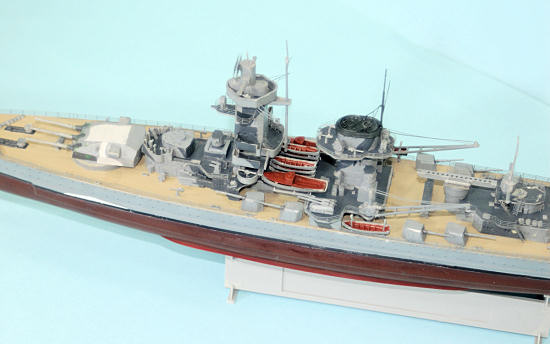 In
Germany,
Hitler, fearful of what might happen if a ship with the name Deutschland were
sunk, ordered her name changed to Lützow.
In
Germany,
Hitler, fearful of what might happen if a ship with the name Deutschland were
sunk, ordered her name changed to Lützow.
HMS Exeter, which had survived being hit by seven 11-inch shells,
managed to get to
Port Stanley
in the
Falklands,
where repairs necessary to allow her to return to
Britain
took until January 1940 to complete.
Escorted home by
Ark
Royal,
Exeter
underwent an extensive refit lasting from February 1940 to March, 1941.
In November 1941, she joined the
Far East
fleet.
On
February 27, 1942,
Exeter
was damaged in the First
Battle
of the
Java
Sea
and ordered to
Surabaya
for repairs. On March 1, attempting to reach the
Sunda
Strait,
Exeter
was intercepted by the Japanese heavy cruisers Nachi, Haguro, Myoko and
Ashigara and the destroyers Akebono, Inazuma, Yamakaze and
Kawakaze. In the Second
Battle
of the
Java
Sea,
now called The
Battle
of
Bawean
Island,
Exeter
was soon badly damaged, one hit stopping all power. Scuttling charges were set
and she began sinking, only to be hit by a torpedo from the destroyer Inazuma
before she finally sank about
noon.
The escorting destroyers HMS
Encounter and USS Pope were also lost. 800 Allied seamen, Captain
Oliver Gordon, were picked up by the Japanese and became prisoners of war.
Exeter
was discovered in 200 feet of water off
Bawean
Island
in 2007 and is now a War Grave.
In 1956, British director Michael Powell, working from a screenplay by
himself and Emeric Pressburger, made “The Battle of the River Plate,” starring
Peter Finch in his first motion picture role as Langsdorff, with Anthony Quayle
as Harwood. HMNZS Achilles, by that time the Indian Navy's Delhi,
played herself, as does HMS Cumberland; USS Salem played Graf
Spee and HMS Jamaica stood in for Exeter, while HMS
Sheffield is seen as Ajax.
The battle scenes, using real ships that are correct for the period,
makes this the only movie to ever accurately portray a real sea battle from the
days of big gun ships; the initial encounter between Graf Spee and Force
G is done in real time. The film is
overall historically accurate, and was restored in 2009, the 70th
anniversary of the battle. It is
available on
DVD
and highly recommended.
The remains of Graf Spee lie in 36 feet of water in the roadstead
off
Montevideo
and are still visible from the shore.
Trumpeter's Graf Spee was released in 2009, the 70th
anniversary of the
Battle
of the River Plate, shortly after the release of another 1/350 kit of the ship
by Academy. Overall, the Trumpeter
release is more detailed than the simpler (and cheaper by half) Academy kit,
though there was a lot of initial discussion among ship modelers as to which kit
was more accurate in shape and dimensions, with Academy's kit winning by a nose,
though the more extensive detail of the Trumpeter kit gives the final product a
better look.
The kit features the now-standard Trumpeter choice of a full hull or a
waterline kit, with the two part hull divided on the waterline with the lower
part molded in dark red plastic.
Photoetch railings are provided, but no other photoetch detail.
The Ar-196 is molded in clear plastic and features a choice of wings
spread or folded.
The first thing to do was to get the necessary information about how Graf
Spee looked at the
Battle
of the River Plate. Fortunately,
Trumpeter provides an accurate painting guide for this.
I also discovered that the Ar-196 had been jettisoned overboard on
December 6 after suffering damage in a heavy landing, and so was not aboard
during the battle.
For me, a ship model starts with painting various parts. I did all the
superstructure parts in light grey, then pa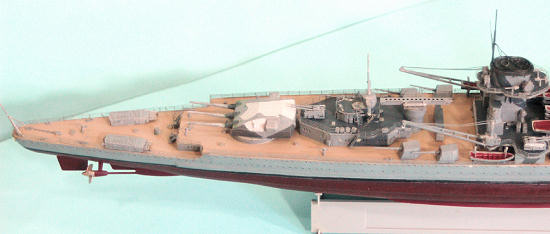 inted the deck parts with Tamiya
“Deck Tan.”
inted the deck parts with Tamiya
“Deck Tan.”
I then assembled the hull, including the main decks, and then painted
that. I hand-painted the “bow wave”
camouflage.
I hand-painted the boats as I assembled them.
I proceeded to follow the instructions and assemble the superstructure,
painting the decks dark grey, and repainting the parts as necessary as they were
assembled.
Once everything was assembled and the superstructure attached, I turned
to the photoetch. Eduard makes a
nice photoetch set, as does White Ensign Models. I proceeded to use both sets,
deciding on my own which bit was superior and using that.
I hate doing photoetch in 1/350 scale, but in that scale you really have
to do it if you want to have a final result that looks realistic.
Take your time and work carefully.
I don't use all the photoetch, because much of it is too small for me to
work with, but if you use at least the ladders and railings and various
yardarms, the radar antenna and the airplane catapult assembly, you end up with
a good looking model. You
definitely need an Opti-Visor when working in this scale.
After all this was assembled, I attached the secondary armament and the
anti-aircraft armament, which I glued in place, while leaving the main armament
free to move. I didn't fully rig
the model. Once I get a closed
display case where certain felines cannot be attracted to such a delightful
spiderweb as a rigged ship, this will be set right.
The Trumpeter Graf Spee makes up into a beautiful model.
I only wish the company would now make some models of the winners; you
know, British County-class heavy
cruiser, Leander-class light cruisers, a US Baltimore and Helena - the ships
that won the war as well as all the ships of the German and Japanese navies that
lost.
Tom Cleaver
November 2011
Thanks to Stephens
International for the review kit.
If you would like your product reviewed fairly and fairly quickly, please contact the editor or see other details in the
Note to
Contributors.
Back to the Main Page
Back to the Review
Index Page


 The ships were primarily designed to operate as open ocean commerce
raiders, powered by four
The ships were primarily designed to operate as open ocean commerce
raiders, powered by four  Between September 30 and
Between September 30 and  Exeter, having suffered 61 dead and 23 wounded, with only her after
turret able to fire, returned to the action at 0700 and scored the most
important hit of the battle when she struck Graf Spee just abaft her
aircraft catapult on the starboard side.
This wrecked the machinery for mixing diesel fuel with desalinated water,
as well as destroying the ship's desalinization system.
Graf Spee again hit Exeter, forcing her to pull out of the
action altogether, with a list to port.
Exeter, having suffered 61 dead and 23 wounded, with only her after
turret able to fire, returned to the action at 0700 and scored the most
important hit of the battle when she struck Graf Spee just abaft her
aircraft catapult on the starboard side.
This wrecked the machinery for mixing diesel fuel with desalinated water,
as well as destroying the ship's desalinization system.
Graf Spee again hit Exeter, forcing her to pull out of the
action altogether, with a list to port. In
In  inted the deck parts with Tamiya
“Deck Tan.”
inted the deck parts with Tamiya
“Deck Tan.”